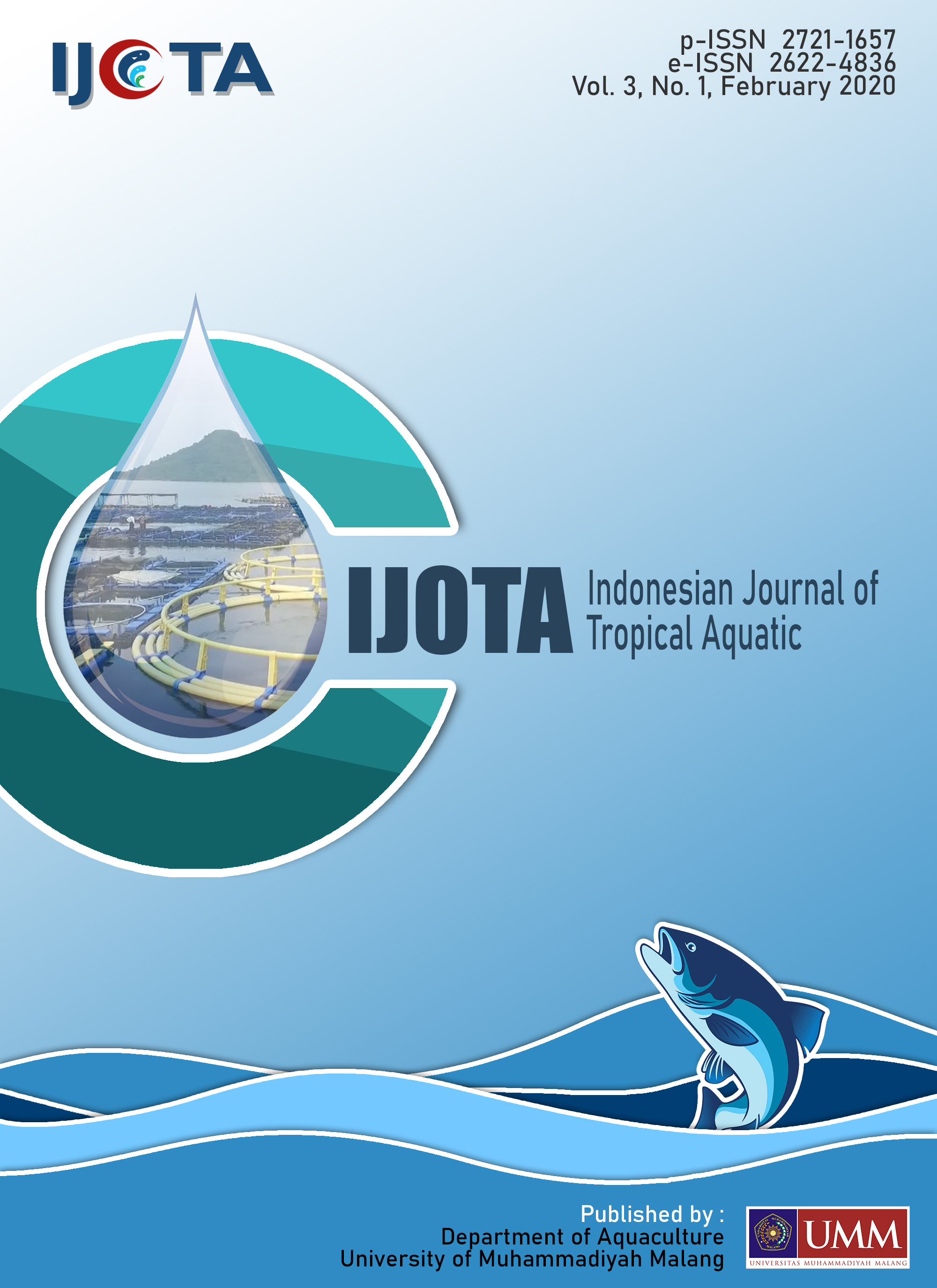Effect of differences in stocking density in round tarpaulin ponds on growth and survival of Osphronemus gourami
DOI:
https://doi.org/10.22219/ijota.v3i1.5973Keywords:
feed conversion rate, gouramy, growth performances, stocking densityAbstract
One way to increase cultivation productivity is by increasing stocking. Gouramy is a freshwater commodity that has a fairly slow growth performance. This study aims to determine the growth performance of gouramy reared at different stocking densities. The 3 cm gourami are reared in a pond containing 35 liters of water. ponds P1 (30 heads), P2 (50 heads), P3 (100 heads), P4 (150 heads), P5 (200 heads) each was repeated 3 times. Growth rate (GR), specific growth rate (SGR), survival rate (SR), and feed conversion ratio (FCR) were measured and analyzed for variance (ANOVA) followed by LSD. The results showed that the fish reared in pond P1 showed the best GR, SGR, FCR, and SR (3.8 g, 3.99 %, 96 %, and 1.11 respectively). The lower the density, the better the growth performance but based on efficiency and productivity the best is at P2.Downloads
References
Abidin Z. 2009. Kinerja Produksi Benih Gurami Osphronemus gouramy Lac Ukuran 8 cm Dengan Padat Penebaran 3, 6 dan 9 ekor/liter Pada Sistem Resirkulasi. Skripsi. Program Studi Teknologi dan Manajemen Perikanan Budidaya. FPIK IPB. Bogor.
Arifin OZ, Prakoso VA, Subagja J, Kristanto AH, Pouil S, Slembrouck J. 2019. Effects of stocking density on survival, food intake, and growth of giant gourami (Osphronemus goramy) larvae reared in a recirculating aquaculture system. Aquaculture, 509, 159-166.
Handajani H. 2006. Pemanfaatan tepung Azolla sebagai penyusun pakan ikan terhadap Pertumbuhan dan Daya Cerna Ikan Nila Gift (Oreochiomis SP). Jurnal Gamma, 1(2).
SNI. 2000. Induk Ikan Gurami (Osphronemus gouramy, Lac) Kelas Induk Pokok (Parent Stock). Badan Standar Nasional.
Maryam S. 2010. Budidaya Super Intensif Ikan Nila Merah Oreochromis sp. dengan Teknologi Bioflok: Profil Kualitas Air, Kelangsungan Hidup, dan Pertumbuhan. Fakultas Perikanan dan Ilmu Kelautan, Institut Pertanian Bogor, 66.
McIntosh RP. 2001. Changing paradigms in shrimp farming: V. Establishment of heterotrophic bacterial communities. Global Aquaculture Advocate, 4(1), 53-58.
Mijani R. 2017. Peer Review: Manajemen Kualitas Air Pada Budidaya Ikan di Kolam Plastik Dengan Water Recycling Technic.
New MB. 1995. Status of freshwater prawn farming: a review. Aquaculture Research, 26(1), 1-54.
Purnomo P. 2012. Pengaruh penambahan karbohidrat pada media pemeliharaan melalui teknologi bioflok terhadap produksi budidaya intensif nila (Oreochromis niloticus). Skripsi. Fakultas Perikanan dan Ilmu Kelautan Universitas Diponegoro. Semarang.
Saparinto C. 2014. Bisnis ikan konsumsi di lahan sempit: Penebar Swadaya Grup.
Shafrudin, Yuniarti, Setiawati M. 2006. Pengaruh kepadatan benih ikan Lele Dumbo (Clarias sp) terhadap produksi pada sistem budidaya dengan pengendalian nitrogen melalui penambahan tepung terigu. Jurnal Akuakultur Indonesia, 5(2), 137-147.
Sudjana M. 1996. Metoda Statistika Edisi 6. In: Bandung, Penerbit Tarsito.
Taw N. 2014. Shrimp farming in biofloc system: Review and recent developments. Paper presented at the Australia: World Aquaculture Conference.
Unisa R. 2000. Pengaruh Padat Penebaran Ikan terhadap Pertumbuhan dan Kelangsungan Hidup Ikan Lele Dumbo (Clarias sp.) dalam Sistem Resirkulasi dengan Debit Air 33 lpm. m-3. Skripsi. Jurusan Budidaya Perairan. Fakultas Perikanan dan Ilmu Kelautan. IPB. Bogor.
Wagiran, Harianto B. 2010. Kiat Sukses Budi Daya Gurami di Kolam Terpal. AgroMedia Pustaka.
Downloads
Published
How to Cite
Issue
Section
License
Copyright (c) 2020 Indonesian Online Journal of Tropical Aquatic

This work is licensed under a Creative Commons Attribution-ShareAlike 4.0 International License.
IJOTA (Indonesian Journal of Tropical Aquatic) allows readers to read, download, copy, distribute, print, search, or link to its articles' full texts and allows readers to use them for any other lawful purpose. The journal allows the author(s) to hold the copyright without restrictions. Finally, the journal allows the author(s) to retain publishing rights without restrictions
- Authors are allowed to archive their submitted article in an open access repository
- Authors are allowed to archive the final published article in an open access repository with an acknowledgment of its initial publication in this journal


